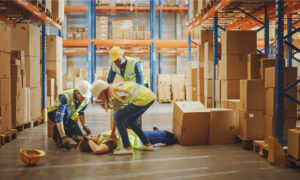Back to: Physical and Health Education JSS 2
Welcome to class!
In today’s class, we shall be talking about the measures of preventing domestic and workplace accident. Please enjoy the class!
Measures of Preventing Domestic and Workplace Accident

Accidents happen. But that doesn’t mean we just shrug and accept them. By understanding the risks and implementing preventive measures, we can significantly reduce the chances of accidents impacting our lives, both at home and in the workplace.
Domestic Dangers: Taming the Familiar

Our homes, those havens of comfort, can also be surprisingly hazardous. Here are some key areas to focus on:
Slips, trips, and falls: These are the most common home accidents, often caused by clutter, spills, and poorly maintained surfaces. Keep floors clear, wipe up spills promptly, and ensure proper lighting in stairways and hallways. Sturdy footwear is your friend!
Fire hazards: Faulty electrical wiring, unattended cooking, and improper storage of flammable materials can turn your home into an inferno. Regular inspections, responsible appliance use, and safe storage of combustibles are crucial.
Poisoning: Children are especially vulnerable to ingesting harmful substances. Keep medications and cleaning products out of reach, store chemicals safely, and educate children about the dangers of unknown substances.
Drowning: Bathtubs, pools, and even toilets can pose drowning risks, especially for children and the elderly. Close supervision, proper safety equipment, and clear water access points are essential.
Workplace Woes: Building a Culture of Safety
The workplace, where we spend a significant portion of our lives, also presents its own set of risks. Here’s how to keep the danger at bay:
Risk assessment and training: Employers have a responsibility to identify and mitigate potential hazards. Proper training on safety procedures, use of equipment, and emergency protocols is crucial for all employees.
Personal protective equipment (PPE): From hard hats and safety glasses to gloves and earplugs, PPE is your shield against workplace hazards. Use it correctly and consistently, and report any damaged or malfunctioning equipment immediately.
Ergonomics and posture: Repetitive strain injuries, muscle fatigue, and back pain are common workplace ailments. Ensure proper workstation setup, take regular breaks, and practice good posture to minimize these risks.
Reporting hazards and near misses: Don’t be a silent bystander. Report any potential hazards or near misses to your supervisor. A proactive approach can prevent future accidents.
By incorporating these measures into your daily life, you can build a strong shield against accidents, both at home and in the workplace. Remember, safety is not just a good idea, it’s a necessity for a happy and healthy life.
We have come to the end of today’s class. I hope you enjoyed the class!
In case you require further assistance or have any questions, feel free to ask in the comment section below, and trust us to respond as soon as possible. Cheers!
Question Time:
- What are the most common types of accidents in homes and workplaces?
- What are the main factors that contribute to accidents in these settings?
- Why is it important to implement preventive measures for both domestic and workplace accidents?
- How can individual action and organizational responsibility work together to create a safer environment?
